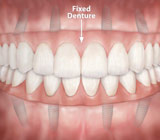A World-Class Smile
 He’s the world’s highest-paid soccer player: a forward on the Spanish club Real Madrid, and captain of the Portuguese national team. His super-toned body is featured in a series of advertisements, and he’s regularly seen with a supermodel on his arm. So would it surprise you to know that it took a bit of dental work to help Cristiano Ronaldo get a world-class smile?
He’s the world’s highest-paid soccer player: a forward on the Spanish club Real Madrid, and captain of the Portuguese national team. His super-toned body is featured in a series of advertisements, and he’s regularly seen with a supermodel on his arm. So would it surprise you to know that it took a bit of dental work to help Cristiano Ronaldo get a world-class smile?
You might never guess it to look at him now — but when he was 18 years old, and just starting his professional career with Manchester United in England, Ronaldo wore ceramic braces to correct a set of teeth that were quite a bit… off-sides. (As pictures from that time show, his teeth were out of alignment and had irregular spacing.) Yet in a relatively short time, his smile was completely transformed.
Ceramic braces are the treatment of choice for many sports stars and celebrities — and plenty of “regular” folks too. They work just like traditional all-metal braces, exerting a gentle force that slowly moves the teeth into better positions. But they have one major difference: They’re a good deal harder to notice.
That’s because instead of having brackets made of metal, this style of braces uses a high-tech ceramic material to attach the archwire to the teeth. The brackets blend right in with the natural shade of the tooth, so all you can see from a distance is the thin metal wire. That makes them a great orthodontic option for image-conscious celebs (like Tom Cruise and Faith Hill, who both wore them) — as well as anyone who may be concerned that traditional metal braces don’t fit in with their “look”.
In addition to ceramic braces, there are other, less-visible orthodontic treatments that can work just as well in many situations. One is lingual braces, which are similar to traditional braces — except they are applied on the tongue-side of the teeth, making them truly invisible. Another is clear aligners, a series of transparent plastic trays that are worn 22 hours a day and gradually move the teeth into more pleasing positions. What’s the best way to know which system is right for you? Come in and talk to us about your options!
Besides braces, did Cristiano Ronaldo have other cosmetic dental work (like teeth whitening) done? It’s possible, but he’s not saying exactly. Yet, as he told a Portuguese magazine, “I feel good about myself and that’s the most important thing.”
Frequently Asked Questions about Fixed Dentures
 Q: Is there much of a difference between fixed and removable dentures?
Q: Is there much of a difference between fixed and removable dentures?
A: There’s a BIG difference! Removable dentures are the type your grandparents might have had — and possibly their grandparents, too. They work well enough after you get used to them, but there’s always the issue of slippage, poor fit, limited function… and potential embarrassment. Modern fixed dentures, however, get their stability from today’s state-of-the-art system for tooth replacement: dental implants. They won’t loosen or slip, they function and “feel” like your own natural teeth, and they can last for years and years to come.
Q: How are fixed dentures supported?
A: Each arch (set of teeth comprising the top or bottom jaw) of a fixed denture is anchored into the jaw bone by four or more dental implants. These small screw-like devices, made of titanium metal, are placed into the jawbone in a minor surgical procedure. Once set in place, they remain permanently attached by both mechanical forces and osseointegration — the process in which living bone cells actually become fused with the metal implants themselves.
Q: What is the procedure for getting dental implants like?
A: Before having any work done, you will receive a thorough examination and have a set of diagnostic images made. Implant surgery is normally performed in the dental office, using local anesthesia or conscious sedation. If any failing teeth must be extracted (removed), that will be done first. Next, small openings are made in the gums and the jawbone, and the implants are placed in precise locations. Sometimes, a set of temporary teeth can be attached to the implants immediately; other times, the implants will be allowed to heal for a period of time.
Q: Besides added stability, are there other advantages to fixed dentures?
A: Yes! As they become integrated in the jaw, dental implants actually help preserve the quantity and quality of bone in the jaw; removable dentures, on the other hand, decrease bone quantity and quality. This is important because the jawbone plays a vital role in supporting facial features like lips and cheeks. When the facial features lose support, it can make a person look prematurely aged. Also, people who wear removable dentures often have trouble eating “challenging” foods like raw fruits and vegetables (which are highly nutritious), and opt for softer, more processed (and less nutritious) foods. With fixed dentures, however, you can eat the foods you like.
Q: Aren’t fixed dentures with dental implants more expensive?
A: Initially, the answer is yes — but in the long run, they may not be. Unlike removable dentures, which inevitably need to be re-lined or remade as the jawbone shrinks, fixed dentures can last for the rest of your life. They don’t require adhesives or creams, and you will never have to take them out at night and clean them. In fact, you can think of them as a long-term investment in yourself that pays off with a better quality of life!
Learn About Living the Life You Love with Designer Nate Berkus
 Design expert and television celebrity Nate Berkus has definite ideas about how to live. In a recent interview, he explained his ideas on design. He also talked about health, and how he keeps his teeth and mouth healthy.
Design expert and television celebrity Nate Berkus has definite ideas about how to live. In a recent interview, he explained his ideas on design. He also talked about health, and how he keeps his teeth and mouth healthy.
From an initial design makeover that he did eight years ago on the Oprah Winfrey Show, Berkus has gone on to do 127 such makeovers. He was such a success that he now hosts his own daily talk show. He has also developed a line of home products for the Home Shopping Network and has his own design firm, Nate Berkus Associates. His clients include well-known restaurants and hotels as well as private homes. He has written articles for O Magazine and authored a book on the subject of transforming your home into a place you love.
“I realized many years ago that I wasn’t going on Oprah to pick sofa colors and paint chips. I was there to lift people up through the way they live,” he says. His secret to design success is to “go with what you love.” He says, “Don’t worry about mixing metals, eras or styles. If you love each item, you’ll find a way to make it work.”
His common sense practical attitude continues when it comes to dental health. Berkus is blessed with a healthy mouth and teeth. He doesn’t feel anxious when visiting the dentist because he usually has a good report. He has not needed orthodontics or cosmetic dentistry. He thanks his childhood dentist for giving him fluoride treatments and sealants, and for teaching him healthy dental hygiene habits.
Berkus brushes his teeth twice or even three times a day, with a manual or electric toothbrush — depending on whether he is at home or traveling. He also follows his dentist’s advice about flossing: “Floss the ones you want to keep!” He says that he tried tooth whitening once, but he felt that the whiteness was “too white.” Now he simply works to maintain his natural tooth color and smile.




